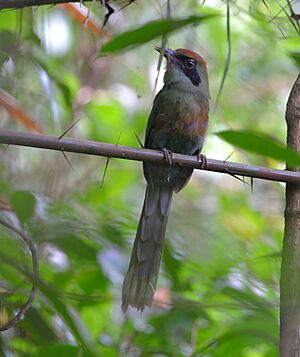Rufous-capped motmot facts for kids
Quick facts for kids Rufous-capped motmot |
|
|---|---|
 |
|
| In Serra do Mar State Park, São Paulo State, Brazil | |
| Conservation status | |
| Scientific classification | |
| Genus: |
Baryphthengus
|
| Species: |
ruficapillus
|
 |
|
The rufous-capped motmot (scientific name: Baryphthengus ruficapillus) is a colorful bird. It belongs to the Momotidae family. You can find this bird in parts of Argentina, Brazil, and Paraguay.
Contents
About the Rufous-capped Motmot
The rufous-capped motmot is one of two types of birds in its group, called Baryphthengus. The other is the rufous motmot. Scientists once thought these two birds might be the same species. However, they are now known to be different. The rufous-capped motmot does not have different types or subspecies within its own group.
What Does It Look Like?
This bird is about 42 centimeters (16.5 inches) long. It weighs between 140 and 151 grams (about 5 ounces). Adult motmots are mostly green on their backs. Their undersides are a greenish-olive color.
They have a reddish-brown cap on their head and neck. A black "mask" covers their eyes. This mask has a pretty turquoise border. On their chest, they have a black spot. A reddish-brown band crosses their belly. The lower part of their belly is blue-green. Young motmots look similar to adults but their colors are not as bright.
Where Does It Live?
The rufous-capped motmot lives in southeastern Brazil. You can also find it in eastern Paraguay. It lives in the far northeastern part of Argentina too. This bird likes to live in old, natural forests. It also lives in forests found along rivers and streams. These birds can be found from areas near the sea up to 1,200 meters (about 3,900 feet) high.
How It Behaves
What Does It Eat?
The rufous-capped motmot eats many different things. Its diet includes insects and their young. It also eats spiders and snails. Sometimes, it hunts small reptiles, mammals, and even other birds. It also eats some fruits. These birds have been seen following army ants. They catch other small creatures that the ants scare out of hiding. They sometimes join other bird groups to find food.
Reproduction and Life Cycle
Rufous-capped motmots build their nests in burrows. They dig these burrows in earth banks. Sometimes, they use burrows that other animals, like armadillos, have left behind. These burrows can be longer than 1 meter (3 feet).
The female bird usually lays two or three eggs. They likely lay eggs in September and October. This is based on when young birds have been seen. Both the male and female parents help feed their young.
What Does It Sound Like?
The rufous-capped motmot mostly sings before the sun comes up and when it sets. It makes a series of "hoo-oo-oo-oo-oo" sounds. People have compared these calls to the sounds that owls make. You can listen to its call online [1].
Conservation Status
The IUCN (International Union for Conservation of Nature) has listed the rufous-capped motmot as a species of "Least Concern." This means it is not currently in danger of disappearing. It lives across a large area. It also seems to have many birds in its population. Many of these birds live in protected areas. However, forests are being cut down in other places. This deforestation is causing the number of rufous-capped motmots to slowly go down.


